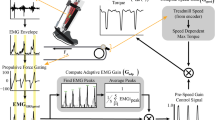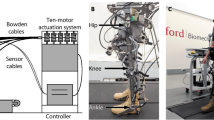Abstract
Slowing the decline in walking mobility in the elderly is critical for maintaining the quality of life. Wearable assistive devices may 1 day facilitate mobility in older adults; however, we need to ensure that such devices do not impair stability in this population that is predisposed to fall-related injuries. This study sought to quantify the effects of untethered ankle exoskeleton assistance on measures of stability, whole-body dynamics, and strategies to maintain balance during normal and perturbed walking in older adults. Eight healthy participants (69–84 years) completed a treadmill-based walking protocol that included perturbations from unexpected belt accelerations while participants walked with and without ankle exoskeleton assistance. Exoskeleton assistance increased frontal plane range of angular momentum (8–14%, p ≤ 0.007), step width (18–34%, p ≤ 0.006), and ankle co-contraction (21–29%, p ≤ 0.039), and decreased biological ankle moment (16–27%, p ≤ 0.001) during unperturbed and perturbed walking; it did not affect the anteroposterior margin-of-stability, step length, trunk variability, or soleus activity during unperturbed and perturbed walking. Our finding that ankle exoskeleton assistance did not affect the anteroposterior margin-of-stability supports additional investigation of assistive exoskeletons for walking assistance in the elderly.




Similar content being viewed by others
References
Bai, S., M. R. Islam, V. Power, and L. OŚullivan. User-centered development and performance assessment of a modular full-body exoskeleton (AXO-SUIT). Biomim. Intell. Robot. 2:100032, 2022.
Bayón, C., A. Q. L. Keemink, M. van Mierlo, W. Rampeltshammer, H. van der Kooij, and E. H. F. van Asseldonk. Cooperative ankle-exoskeleton control can reduce effort to recover balance after unexpected disturbances during walking. J. NeuroEng. Rehabil. 19:21, 2022.
Beijersbergen, C. M. I., U. Granacher, A. A. Vandervoort, P. DeVita, and T. Hortobágyi. The biomechanical mechanism of how strength and power training improves walking speed in old adults remains unknown. Ageing Res. Rev. 12:618–627, 2013.
Bierbaum, S., A. Peper, K. Karamanidis, and A. Arampatzis. Adaptational responses in dynamic stability during disturbed walking in the elderly. J. Biomech. 43:2362–2368, 2010.
Bishe, S. S. P. A., T. Nguyen, Y. Fang, and Z. F. Lerner. Adaptive ankle exoskeleton control: validation across diverse walking conditions. IEEE Trans. Med. Robot. Bionics. 3:801–812, 2021.
Blake, A. J., K. Morgan, M. J. Bendall, H. Dallosso, S. B. J. Ebrahim, T. H. D. Arie, P. H. Fentem, and E. J. Bassey. Falls by elderly people at home: prevalence and associated factors. Age Ageing. 17:365–372, 1988.
Daly, R. M., B. E. Rosengren, G. Alwis, H. G. Ahlborg, I. Sernbo, and M. K. Karlsson. Gender specific age-related changes in bone density, muscle strength and functional performance in the elderly: a-10 year prospective population-based study. BMC Geriatr. 2013. https://doi.org/10.1186/1471-2318-13-71.
Delp, S. L., F. C. Anderson, A. S. Arnold, P. Loan, A. Habib, C. T. John, E. Guendelman, and D. G. Thelen. OpenSim: open-source software to create and analyze dynamic simulations of movement. IEEE Trans. Biomed. Eng. 54:1940–1950, 2007.
Fang, Y., K. Harshe, J. R. Franz, and Z. F. Lerner. Feasibility evaluation of a dual-mode ankle exoskeleton to assist and restore community ambulation in older adults. Wearable Technol. 3:e13, 2022.
Finkelstein, E. A., P. S. Corso, and T. R. Miller. The Incidence and Economic Burden of Injuries in the United States. Oxford: Oxford University Press, pp. 1–202, 2009. https://doi.org/10.1093/acprof:oso/9780195179484.001.0001.
Fujimoto, M., and L.-S. Chou. Sagittal plane momentum control during walking in elderly fallers. Gait Posture. 45:121–126, 2016.
Gasparri, G. M., J. Luque, and Z. F. Lerner. Proportional joint-moment control for instantaneously adaptive ankle exoskeleton assistance. IEEE Trans. Neural Syst. Rehabil. Eng. 27:751–759, 2019.
Grabiner, M. D., S. Donovan, M. Lou Bareither, J. R. Marone, K. Hamstra-Wright, S. Gatts, and K. L. Troy. Trunk kinematics and fall risk of older adults: translating biomechanical results to the clinic. J. Electromyogr. Kinesiol. 18:197–204, 2008.
Granata, K. P., and T. E. Lockhart. Dynamic stability differences in fall-prone and healthy adults. J. Electromyogr. Kinesiol. 18:172–178, 2008.
Harvey, T. A., B. C. Conner, and Z. F. Lerner. Does ankle exoskeleton assistance impair stability during walking in individuals with cerebral palsy? Ann. Biomed. Eng. 49:2522–2532, 2021.
Hnat, S. K., and A. J. van den Bogert. Inertial compensation for belt acceleration in an instrumented treadmill. J. Biomech. 47:3758–3761, 2014.
Hof, A. L., M. G. J. Gazendam, and W. E. Sinke. The condition for dynamic stability. J. Biomech. 38:1–8, 2005.
Jeon, W., L. Griffin, and H. Y. Hsiao. Effects of initial foot position on postural responses to lateral standing surface perturbations in younger and older adults. Gait Posture. 90:449–456, 2021.
Kang, H. G., and J. B. Dingwell. Dynamic stability of superior vs. inferior segments during walking in young and older adults. Gait Posture. 30:260–263, 2009.
Kapsalyamov, A., P. K. Jamwal, S. Hussain, and M. H. Ghayesh. State of the art lower limb robotic exoskeletons for elderly assistance. IEEE Access. 7:95075–95086, 2019.
Kim, D., and J. M. Hwang. The center of pressure and ankle muscle cocontraction in response to anterior-posterior perturbations. PLoS ONE. 13:e0207667, 2018.
Kong, K., and D. Jeon. Design and control of an exoskeleton for the elderly and patients. IEEE/ASME Trans. Mechatron. 11:428–432, 2006.
Kurz, M. J., D. J. Arpin, and B. Corr. Differences in the dynamic gait stability of children with cerebral palsy and typically developing children. Gait Posture. 36:600–604, 2012.
Lee, H. J., and L. S. Chou. Detection of gait instability using the center of mass and center of pressure inclination angles. Arch. Phys. Med. Rehabil. 87:569–575, 2006.
Leestma, J. K., P. R. Golyski, C. R. Smith, G. S. Sawicki, and A. J. Young. Linking whole-body angular momentum and step placement during perturbed human walking. J. Exp. Biol. 226:jeb244760, 2023.
Lerner, Z. F., D. L. Damiano, and T. C. Bulea. A robotic exoskeleton to treat crouch gait from cerebral palsy: initial kinematic and neuromuscular evaluation. In: Proceedings of the Annual International Conference of the IEEE Engineering in Medicine and Biology Society, EMBS 2016-October. 2016, pp. 2214–2217.
Martelli, D., F. Vannetti, M. Cortese, P. Tropea, F. Giovacchini, S. Micera, V. Monaco, and N. Vitiello. The effects on biomechanics of walking and balance recovery in a novel pelvis exoskeleton during zero-torque control. Robotica. 32:1317–1330, 2014.
McCrum, C., G. Epro, K. Meijer, W. Zijlstra, G.-P. Brüggemann, and K. Karamanidis. Locomotor stability and adaptation during perturbed walking across the adult female lifespan. J. Biomech. 49:1244–1247, 2016.
Neptune, R. R., and C. P. McGowan. Muscle contributions to whole-body sagittal plane angular momentum during walking. J. Biomech. 44:6–12, 2011.
Orekhov, G., Y. Fang, C. F. Cuddeback, and Z. F. Lerner. Usability and performance validation of an ultra-lightweight and versatile untethered robotic ankle exoskeleton. J. NeuroEng. Rehabil. 2021. https://doi.org/10.1186/s12984-021-00954-9.
Perry, J. A., and M. Srinivasan. Walking with wider steps changes foot placement control, increases kinematic variability and does not improve linear stability. R. Soc. Open Sci. 4:160627, 2017.
Rosenblatt, N. J., and M. D. Grabiner. Measures of frontal plane stability during treadmill and overground walking. Gait Posture. 31:380–384, 2010.
Rudolph, K. S., M. J. Axe, and L. Snyder-Mackler. Dynamic stability after ACL injury: who can hop? Knee Surg. Sports Traumatol Arthrosc. 8:262–269, 2000.
Sawicki, G. S., O. N. Beck, I. Kang, and A. J. Young. The exoskeleton expansion: improving walking and running economy. J. NeuroEng. Rehabil. 2020. https://doi.org/10.1186/s12984-020-00663-9.
Schoene, D., C. Heller, Y. N. Aung, C. C. Sieber, W. Kemmler, and E. Freiberger. A systematic review on the influence of fear of falling on quality of life in older people: is there a role for falls? Clin. Interv. Aging. 14:701–719, 2019.
Silverman, A. K., and R. R. Neptune. Differences in whole-body angular momentum between below-knee amputees and non-amputees across walking speeds. J. Biomech. 44:379–385, 2011.
Simoneau, G. C., and D. E. Krebs. Whole-body momentum during gait: a preliminary study of non-fallers and frequent fallers. J. Appl. Biomech. 16:1–13, 2000.
Siragy, T., and J. Nantel. Quantifying dynamic balance in young, elderly and Parkinson’s individuals: a systematic review. Front. Aging Neurosci. 10:387, 2018.
Süptitz, F., K. Karamanidis, M. M. Catalá, and G. P. Brüggemann. Symmetry and reproducibility of the components of dynamic stability in young adults at different walking velocities on the treadmill. J. Electromyogr. Kinesiol. 22:301–307, 2012.
Toebes, M. J. P., M. J. M. Hoozemans, R. Furrer, J. Dekker, and J. H. Van Dieën. Local dynamic stability and variability of gait are associated with fall history in elderly subjects. Gait Posture. 36:527–531, 2012.
Acknowledgements
This work was supported in part by Mary M. Winn-Radcliff and Gregory M. Winn through the Northern Arizona University Foundation. The authors thank Karl Harshe, Greg Orekhov, and Leah Liebelt for their assistance with this study.
Funding
Funding was provided by Northern Arizona University.
Author information
Authors and Affiliations
Corresponding author
Ethics declarations
Conflict of interest
ZFL is a named inventor on awarded patents and pending utility patent applications that cover the aspects of the robotic device utilized in the study. He is also a co-founder of a company seeking to commercialize the device.
Additional information
Associate Editor Stefan M. Duma oversaw the review of this article.
Publisher's Note
Springer Nature remains neutral with regard to jurisdictional claims in published maps and institutional affiliations.
Supplementary Information
Below is the link to the electronic supplementary material.
Rights and permissions
Springer Nature or its licensor (e.g. a society or other partner) holds exclusive rights to this article under a publishing agreement with the author(s) or other rightsholder(s); author self-archiving of the accepted manuscript version of this article is solely governed by the terms of such publishing agreement and applicable law.
About this article
Cite this article
Fang, Y., Lerner, Z.F. How Adaptive Ankle Exoskeleton Assistance Affects Stability During Perturbed and Unperturbed Walking in the Elderly. Ann Biomed Eng 51, 2606–2616 (2023). https://doi.org/10.1007/s10439-023-03310-1
Received:
Accepted:
Published:
Issue Date:
DOI: https://doi.org/10.1007/s10439-023-03310-1




